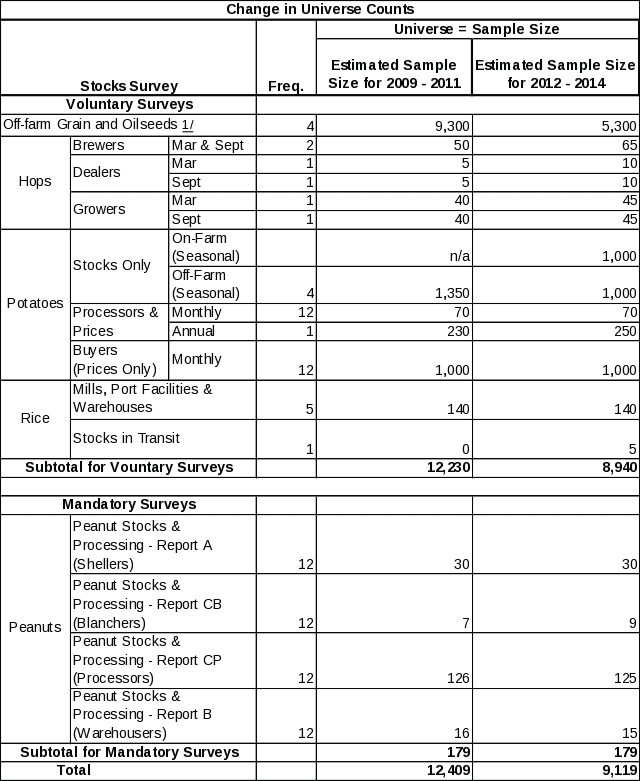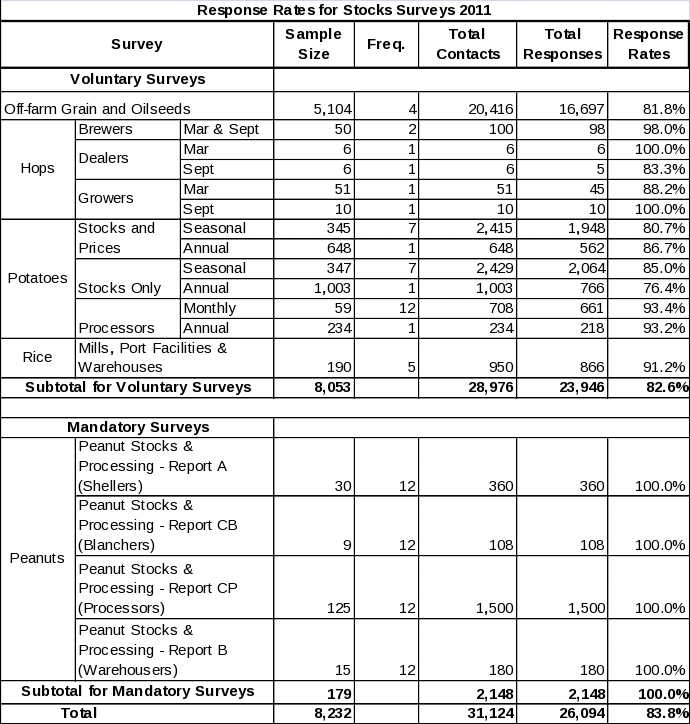0007-stocks-12-SSB
0007-stocks-12-SSB.docx
Stocks Reports
OMB: 0535-0007
Supporting Statement
STOCKS REPORTS
OMB No. 0535-0007
B. COLLECTION OF INFORMATION EMPLOYING STATISTICAL METHODS
1. Describe (including a numerical estimate) the potential respondent universe and any sampling or other respondent selection method to be used. Data on the number of entities (e.g., establishments, State and local government units, households, or persons) in the universe covered by the collection and in the corresponding sample are to be provided in tabular form for the universe as a whole and for each of the strata in the proposed sample. Indicate expected response rates for the collection as a whole. If the collection has been conducted previously, include the actual response rate achieved during the last collection.
The following tables show change in universe sizes and response rates for each of the stock surveys. These are censuses, so universe count equals sample size.

n/a – The on-farm stocks survey will be instituted starting for the 2013 for the 2012 crop.
1/ The 5,300 parent operations for the 2012 – 2014 sample size will report data for the 8,800 off farm grain storage facilities.

2. Describe the procedures for the collection of information including:
• statistical methodology for stratification and sample selection,
• estimation procedure,
• degree of accuracy needed for the purpose described in the justification,
• unusual problems requiring specialized sampling procedures
The off-farm stocks survey for grains is an enumeration of all known commercial grain storage facilities, approximately 8,900 facilities with about 10.1 billion bushels of storage capacity. Many of these facilities are operated by parent companies where one respondent will report for multiple facilities. In 2011, about 5,300 companies operated the 8,900 facilities. An effort is made to obtain a report for all facilities. Reports of stock holdings are normally received from operations covering about 90 percent of the capacity. Estimates are made for missing facilities to make the survey complete. Off-farm survey data are reviewed at the State and national levels for reasonableness, consistency with historical estimates, and current crop size. After estimates are made for on-farm and off-farm, the two are combined and evaluated using a balance sheet approach. This method utilizes other sources of data to check the reasonableness of the stocks estimates. Estimates of production, imports, exports, crushings, milling, and all other recorded uses of grain and oilseeds are reviewed to make sure beginning stocks, production, utilization, and ending stocks are within reasonable balance and present the best possible estimate of all stocks.
Stocks for the other commodities except peanuts are enumerated in the same manner. Peanut stocks and processing survey data are collected from shellers, blanchers, processors, and warehouses directly by Headquarters through mail questionnaires and electronic data reporting (EDR). The Peanut Stocks survey is a mandatory survey. Respondent businesses are accustomed to the survey and Headquarters receives complete cooperation. With the exception of potatoes the stocks universes are very small and the response rates are virtually 100 percent.
Potatoes are grown in every State in the U.S. with NASS making production estimates in 31 States. Potatoes are harvested throughout the year somewhere in the country. USDA covers annual production in four seasonal groupings: winter, spring, summer, and fall. Most of the large fall crop is stored in temperature- and humidity-controlled cellars to be held for sale through the late fall, winter, and spring months. The Potato Stocks Survey uses information gathered each June from the Agricultural Surveys Program (OMB No. 0535-0213) area frame survey to measure the completeness of the list frame. The names of off-farm storage operators are obtained from potato processors in each State.
Samples of the stocks questionnaires are attached in the ROCIS system.
Survey indications are subject to non-sampling errors such as omissions, duplication, imputation for missing data, and mistakes in reporting, recording, and processing the data. These errors are not measured directly but they are minimized through rigid quality controls in the data collection process and a careful review of all reported data for consistency and reasonableness.
3. Describe methods to maximize response rates and to deal with issues of non-response. The accuracy and reliability of information collected must be shown to be adequate for intended uses. For collections based on sampling a special justification must be provided for any collection that will not yield "reliable" data that can be generalized to the universe studied.
Reports from central accounting offices of large off-farm grain companies account for about two-thirds of total U.S. capacity. Combining the on-farm and off-farm data provides very reliable indications.
The due date that appears on a questionnaire is related to the reference period and the amount of time we are allotted to collect the data. Some of the surveys that NASS conducts are done on a weekly, monthly, quarterly, seasonal, annual, or some other frequency. For the surveys that are more frequent, we vary the emphasis on the due date shown so that data are received in time to be key-entered, edited, and summarized, and for estimates to be generated and prepared for publishing within the allotted time. As a part of NASS’s charter we are required to publish accurate, useful data in a timely manner. In order for these data to be useful to the public it sometimes requires a very frequent survey, due to the speed at which the data can change.
4. Describe any tests of procedures or methods to be undertaken.
Testing of questionnaires is conducted periodically in small focus groups.
5. Provide the name and telephone number of individuals consulted on statistical aspects of the design and the name of the agency unit, contractor(s), or other person(s) who will actually collect and/or analyze the information for the agency.
The survey design for each State is determined by the Sampling Branch, Census and Survey Division (Sampling Branch Chief is William Iwig (202)720-3895) in conjunction with the Statistical Methods Branch, Statistics Division (Methods Branch Chief is Dave Aune (202)720-4008).
Data collection is carried out by NASS Field Offices; Eastern Field Operation’s Director is Norman Bennett, (202) 720-3638 and the Western Field Operation’s Director is Kevin Barnes (202) 720-8220.
The NASS survey statisticians in Headquarters are responsible for coordination of sampling, questionnaires, data collection, and other Field Office support. Branch Chief is Christina Messer, (202) 690-8747.
There are several NASS commodity statisticians in Headquarters Crops Branch, Statistics Division, who work on the stocks surveys. They are responsible for survey administration, support for FO activities, national summary data, and publication (Crops Branch Chief is Lance Honig (202)720-2127).
August 2012
Revised January 2013
| File Type | application/vnd.openxmlformats-officedocument.wordprocessingml.document |
| File Title | Supporting Statement |
| Author | HoppRi |
| File Modified | 0000-00-00 |
| File Created | 2021-01-30 |
© 2025 OMB.report | Privacy Policy